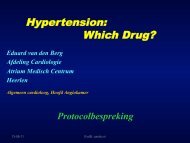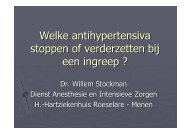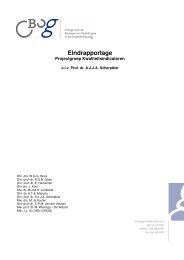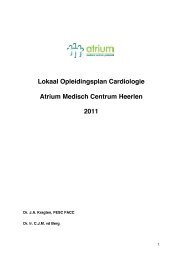Guidelines on the Management of Stable Angina Pectoris ... - Cardio
Guidelines on the Management of Stable Angina Pectoris ... - Cardio
Guidelines on the Management of Stable Angina Pectoris ... - Cardio
You also want an ePaper? Increase the reach of your titles
YUMPU automatically turns print PDFs into web optimized ePapers that Google loves.
ESC <str<strong>on</strong>g>Guidelines</str<strong>on</strong>g> 45mortality is increased three-fold in diabetic men and two- t<strong>of</strong>ive-fold in diabetic women, compared with age- and sexmatchedn<strong>on</strong>-diabetic pers<strong>on</strong>s. 81,636–638 Moreover, anumber <strong>of</strong> epidemiological reports indicate that in patientswith diabetes, <strong>the</strong> higher <strong>the</strong> blood glucose, <strong>the</strong> greater <strong>the</strong>incidence <strong>of</strong> CVD. 639,640The clinical manifestati<strong>on</strong>s <strong>of</strong> CHD in diabetic subjects aresimilar to those in n<strong>on</strong>-diabetic patients, with angina, MI,and heart failure being <strong>the</strong> most prominent, but <strong>the</strong> symptomstend to occur at an earlier age in diabetic patients.It is generally accepted that <strong>the</strong> prevalence <strong>of</strong> asymptomaticischaemia is increased in patients with diabetes.However, because <strong>of</strong> c<strong>on</strong>siderable variati<strong>on</strong> in inclusi<strong>on</strong>and exclusi<strong>on</strong> criteria as well as screening tests in studiesto date, it is somewhat difficult to estimate <strong>the</strong> increasedfrequency <strong>of</strong> silent ischaemia accurately. 641There is growing interest in <strong>the</strong> use <strong>of</strong> myocardial perfusi<strong>on</strong>scanning and o<strong>the</strong>r techniques to detect ischaemia in asymptomaticdiabetic individuals 642 and firm evidence <strong>of</strong> <strong>the</strong> prognosticpower <strong>of</strong> perfusi<strong>on</strong> imaging specifically in diabeticpatients. 643 There are also data to suggest that individualswith diabetes may have subclinical ventricular dysfuncti<strong>on</strong>which negatively impacts <strong>on</strong> exercise capacity, 644 an importantendpoint <strong>of</strong> exercise testing, but <strong>the</strong> impact <strong>of</strong> thisfinding <strong>on</strong> <strong>the</strong> diagnostic and prognostic informati<strong>on</strong> yieldedby c<strong>on</strong>venti<strong>on</strong>al testing in a symptomatic populati<strong>on</strong> is notclear. Thus, <strong>the</strong> cardiac assessment <strong>of</strong> symptomatic ischaemiain diabetic patients should, in general, parallel that in n<strong>on</strong>diabeticsubjects, with similar indicati<strong>on</strong>s for exercisetesting, myocardial perfusi<strong>on</strong> testing, and cor<strong>on</strong>ary arteriography.As CVD accounts for 80% <strong>of</strong> mortality in patientswith diabetes mellitus, 645 emphasis should be placed <strong>on</strong>early diagnosis and aggressive treatment in this populati<strong>on</strong>.Current strategies for optimal care <strong>of</strong> patients with diabetesmellitus include vigorous and persistent efforts toachieve physiological c<strong>on</strong>trol <strong>of</strong> blood glucose and c<strong>on</strong>trol<strong>of</strong> o<strong>the</strong>r risk factors such as dyslipidaemia, renal disease,obesity, and smoking. Abundant evidence that l<strong>on</strong>g-termmaintenance <strong>of</strong> near-normal blood glucose levels is protective<strong>of</strong> patients with diabetes and substantially reducescomplicati<strong>on</strong>s and mortality in both diabetes type 1 andtype 2 is now available. 645–648C<strong>on</strong>venti<strong>on</strong>al <strong>the</strong>rapies for CHD with nitrates, betablockers,calcium-channel blockers, statins, antiplateletsagents, and cor<strong>on</strong>ary revascularizati<strong>on</strong> procedures havesimilar indicati<strong>on</strong>s in diabetic and n<strong>on</strong>-diabetic patients.Additi<strong>on</strong>ally, ACE-inhibitors are indicated in diabeticpatients with proven vascular disease. 253 The relativemerits <strong>of</strong> PCI and CABG in diabetic patients are discussedin <strong>the</strong> secti<strong>on</strong> <strong>on</strong> Revascularizati<strong>on</strong>. Unfortunately, owingto <strong>the</strong> chr<strong>on</strong>ic metabolic disturbances <strong>of</strong> diabetes mellitus,<strong>the</strong>se patients usually have a c<strong>on</strong>tinuous progressi<strong>on</strong> <strong>of</strong>native a<strong>the</strong>rosclerotic disease, leading to an extensiveCHD with high rates <strong>of</strong> multi-vessel disease and <strong>of</strong> restenosis.649,650 Thus, even after successful invasive procedures,good management <strong>of</strong> CVD risk factors and a tight glycaemicc<strong>on</strong>trol are essential for good l<strong>on</strong>g-term outcome. 638ElderlyAfter <strong>the</strong> age <strong>of</strong> 75 years <strong>the</strong>re is an equal prevalence <strong>of</strong> CADin men and women. 651 The disease is more likely to bediffuse and severe; LM cor<strong>on</strong>ary artery stenosis and threevesseldisease are more prevalent in older patients, as isimpaired LV functi<strong>on</strong>. The evaluati<strong>on</strong> <strong>of</strong> chest pain syndromesin <strong>the</strong> elderly can be difficult because complaints<strong>of</strong> chest discomfort, weakness, and dyspnoea are comm<strong>on</strong>,and co-morbid c<strong>on</strong>diti<strong>on</strong>s that mimic angina pectoris arefrequently present. Reduced activity levels and bluntedappreciati<strong>on</strong> <strong>of</strong> ischaemic symptoms become <strong>the</strong> norm withadvancing age. 652 In large community studies <strong>of</strong> men andwomen .65-years old, those with atypical symptoms andtypical angina were shown to have similar 3 year cardiacmortality rates. 20 The performance <strong>of</strong> exercise testingposes additi<strong>on</strong>al problems in <strong>the</strong> elderly. Functi<strong>on</strong>al capacity<strong>of</strong>ten is compromised from muscle weakness and dec<strong>on</strong>diti<strong>on</strong>ing.More attenti<strong>on</strong> must be given to <strong>the</strong> mechanicalhazards <strong>of</strong> exercise, and less challenging protocols may bemore appropriate. Arrhythmias occur more frequently withincreasing age, especially at higher workloads. 653 Theinterpretati<strong>on</strong> <strong>of</strong> exercise test results in <strong>the</strong> elderly differsfrom that in <strong>the</strong> young. The higher prevalence <strong>of</strong> diseasemeans that more test results are false negative. 654 Falsepositivetest results also are more frequent because <strong>of</strong> <strong>the</strong>higher prevalence <strong>of</strong> c<strong>on</strong>founders such as prior MI, LV hypertrophyfrom valvular diseases, hypertensi<strong>on</strong> and c<strong>on</strong>ducti<strong>on</strong>disturbances. Despite <strong>the</strong>se differences, exercise testingremains important also in <strong>the</strong> elderly. The Task Forcebelieves that exercise ECG testing should remain <strong>the</strong> initialtest in evaluating elderly patients with suspected <strong>of</strong> CADunless <strong>the</strong> patient cannot exercise, in which case it may bereplaced by pharmacological stress imaging.It is important to emphasize that elderly patients withobjective evidence <strong>of</strong> moderate-to-severe ischaemia at n<strong>on</strong>invasivetesting should have similar access to cor<strong>on</strong>ary arteriographyas younger patients. Notably, diagnostic cor<strong>on</strong>aryarteriography has relatively little increased risk (comparedwith younger patients) in older patients undergoing electiveevaluati<strong>on</strong>. 243 However, age .75 is an important predictor<strong>of</strong> c<strong>on</strong>trast-induced nephropathy. 655Medical treatment is more complex in elderly patients.Indeed, changes in drug bioavailability, eliminati<strong>on</strong>, andsensitivity mean that dose modificati<strong>on</strong> is essential whenprescribing cardiovascular drugs to elderly patients. 656Fur<strong>the</strong>r issues which should be taken into account whenprescribing for <strong>the</strong> elderly include risk <strong>of</strong> drug interacti<strong>on</strong>s,polypharmacy, and compliance problems. Never<strong>the</strong>less, inthis patient populati<strong>on</strong>, anti-anginal medicati<strong>on</strong>s are asefficacious in reducing symptoms and statins in improvingprognosis, 438 as <strong>the</strong>y are in young patients. C<strong>on</strong>sideringsymptoms as well as prognosis, elderly patients have <strong>the</strong>same benefit from medical <strong>the</strong>rapy, angioplasty, andbypass surgery as younger patients. 657–659Chr<strong>on</strong>ic refractory anginaDrugs and revascularizati<strong>on</strong> procedures, i.e. CABG and percutaneoustransluminal angioplasty, can adequatelymanage <strong>the</strong> majority <strong>of</strong> patients suffering from ischaemicheart disease. However, <strong>the</strong>re are patients who remainseverely disabled by angina pectoris in spite <strong>of</strong> differentforms <strong>of</strong> c<strong>on</strong>venti<strong>on</strong>al treatment. It is an unfortunate ir<strong>on</strong>ythat <strong>the</strong> prol<strong>on</strong>gati<strong>on</strong> <strong>of</strong> life due to <strong>the</strong> improvement <strong>of</strong>cardiovascular care and treatment are resp<strong>on</strong>sible for anincrease in <strong>the</strong> number <strong>of</strong> patients with end-stage ischaemiccor<strong>on</strong>ary disease, some who complain from intractable episodes<strong>of</strong> angina. The problem <strong>of</strong> chr<strong>on</strong>ic refractory angina














